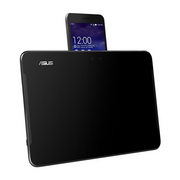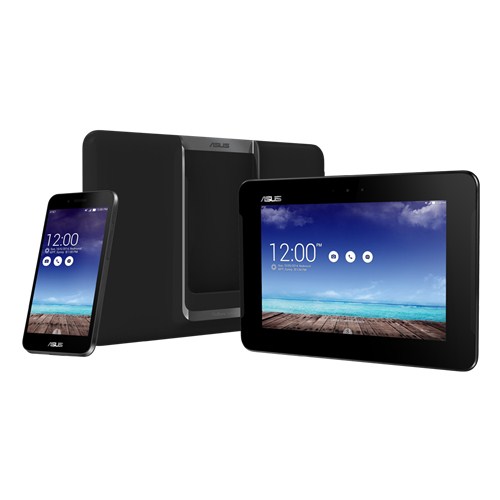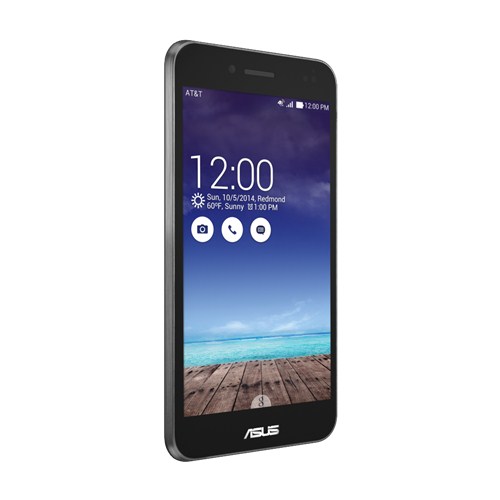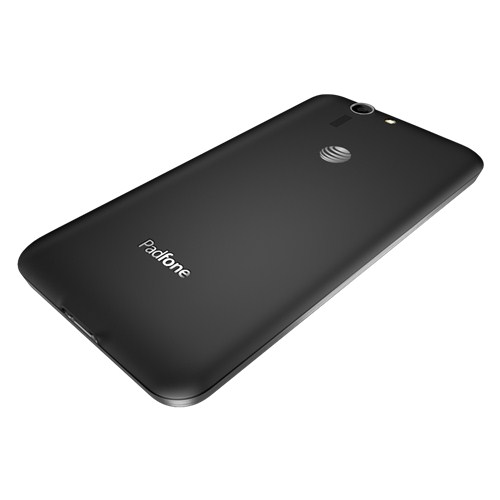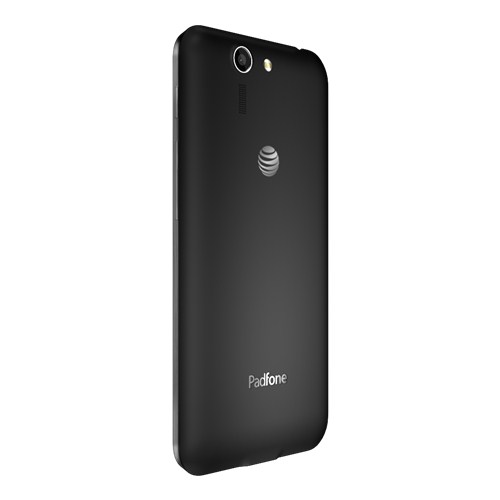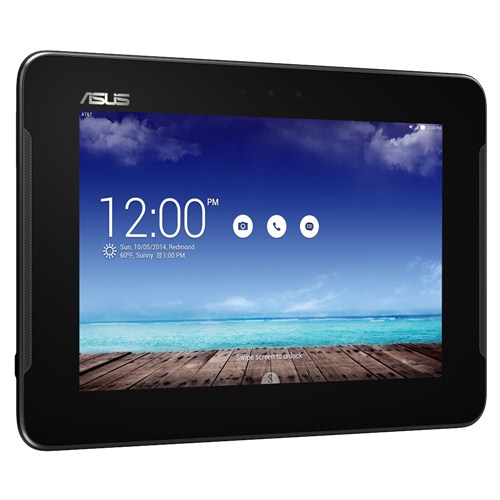Asus PadFone X
Ausstattung / Datenblatt
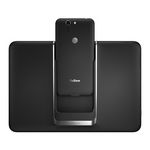
Preisvergleich
Durchschnitt von 4 Bewertungen (aus 8 Tests)
Testberichte für das Asus PadFone X
Quelle: Under KG
 EN→DE Archive.org version
EN→DE Archive.org versionvideo review
Einzeltest, online verfügbar, Sehr kurz, Datum: 14.05.2015
Quelle: NDTV Gadgets
 EN→DE Archive.org version
EN→DE Archive.org versionThis summer, AsusTek Computer Inc. claims you don't need both a phone and a tablet - as long as you get its new PadFone X. The PadFone works like any other phone and has a screen that measures 5 inches diagonally. When you want a tablet experience, you simply slip the phone into a slot on the back of the tablet display, which is included. All the apps on the phone now work on the 9-inch tablet. The phone is what runs the tablet. Asus is bringing this concept to the U.S. for the first time.
Einzeltest, online verfügbar, Sehr kurz, Datum: 29.07.2014
Quelle: GSM Arena
 EN→DE Archive.org version
EN→DE Archive.org versionAfter spending enough time pondering over the good and the bad about the Asus PadFone X, we realized that the hybrid device could well be the ultimate Android offering for user seeking the most value for their money. The gadget does everything a flagship device is expected to do, but with the added benefit of full-sized tablet functionality. It deserves a spot on the shopping list of anyone who wants top-notch hardware in a phone and tablet, but can't stretch his/her budget for two standalone devices.
Einzeltest, online verfügbar, Lang, Datum: 21.07.2014
Quelle: Engadget
 EN→DE Archive.org version
EN→DE Archive.org versionIf I've seemed unduly harsh on the Padfone X, it's because I still think there's a place in the world for a hybrid like this. Sadly, despite years of tinkering with the same formula, ASUS couldn't completely stick the landing this time around. For all the gripes I've leveled at this thing, though, I've had to mentally repeat one sentence like a mantra throughout my weeks of testing: all of this is just $200 with a contract.
Einzeltest, online verfügbar, Lang, Datum: 19.06.2014
Bewertung: Gesamt: 72%
Quelle: Recode
 EN→DE Archive.org version
EN→DE Archive.org versionLike a lot of two-in-one devices, the price of convenience comes with sacrifices. Asus PadFone X isn’t an exceptional smartphone nor is it an outstanding tablet. But if you want both and don’t have a lot of cash to spend, it’s certainly worth consideration.
Einzeltest, online verfügbar, Sehr kurz, Datum: 05.06.2014
Quelle: Laptop Mag
 EN→DE Archive.org version
EN→DE Archive.org versionThe PadFone X is an intriguing device that packs a smartphone and tablet into a single, affordable package. On their own, the two devices are good, but not great. The handset's battery life is relatively short, while the slate is on the heavy side with a distractingly large bezel. Together, though, they make the PadFone X a fairly impressive hybrid at an aggressive price.
Einzeltest, online verfügbar, Lang, Datum: 05.06.2014
Bewertung: Gesamt: 70%
Quelle: Pocketnow
 EN→DE Archive.org version
EN→DE Archive.org versionThe PadFone X isn’t the world’s most attractive smartphone … or tablet. It’s cumbersome, it’s bulky, and whether it offers enough convenience to overcome these setbacks is an open question. In today’s cloud-oriented mobile world, the average person could easily approximate the PadFone’s convenience with a Nexus 5 and a Nexus 10 using Android’s built in handovers, or an iPad and an iPhone using Continuity.
Einzeltest, online verfügbar, Lang, Datum: 04.06.2014
Bewertung: Gesamt: 70% Leistung: 60% Ausstattung: 75% Mobilität: 80%
Quelle: PC Mag
 EN→DE Archive.org version
EN→DE Archive.org versionThe fact is, though, the people most likely to be attracted to the PadFone concept are also probably the type that already own a tablet. And as a smartphone alone, the PadFone X is still a great option, but not quite on the same level as the Galaxy S5 or HTC One (M8). The GS5 is faster, lasts longer, and has a better camera. The HTC One (M8) is the most beautiful phone on the market and has better overall performance as well. Either of those options are better for anyone who already owns a modern tablet, but if you're in the market for a tablet and smartphone upgrade, the PadFone X is a great deal and a solid option.
Einzeltest, online verfügbar, Kurz, Datum: 31.05.2014
Bewertung: Gesamt: 80%
Kommentar
Modell:
Die Unterschiede zwischen Phone und Tablet werden heutzutage immer feiner. Asus ging aber mit einem Gerät, das sowohl Phone als auch Tablet ist, noch einen Schritt weiter! Das Asus PadFone X bietet nicht nur ausgezeichnete Funktionalität, es kostet auch viel weniger als erwartet.
Der 5-Zoll-Bildschirm mit einer Auflösung von 1920 x 1080 Pixeln liefert schöne Bilder. Das Gerät wird durch einen 2,3 GHz Quad-Core-Prozessor und 2 GB RAM angetrieben, sodass die tägliche Verwendung flüssig und nahtlos ist. Zudem bietet es 16 GB nativen Speicher und unterstützt eine externe SD-Karte. Das Asus PadFone X verfügt auch über WiFi 802.11 b/g/n und WEP, WPA und WPA2-Verschlüsselung. Außerdem unterstützt es Bluetooth 4.0. Damit sind grundlegende kabellose Verbindungen verfügbar.
Leider ist das Design etwas mangelhaft. Es ist 172 mm dick und wiegt nur 150 Gramm, womit es weder schlank noch elegant ist. Der matte schwarze Kunststoff sieht ordentlich, aber nicht cool aus. Insgesamt könnte das Asus PadFone X sehr wohl die nächste große Sache sein: 2 Geräte in 1! Sein Design macht es mit ausgezeichneter Qualität und Leistung wett.
Qualcomm Adreno 330: Eingebaut in Qualcomm Snapdragon 800 und 801 SoCs
Diese Karten können nur sehr alte und sehr anspruchslose 3D Spiele flüssig darstellen. Anwendungen wie Office, Internet surfen, Bildbearbeitung oder (SD) Videoschnitt sind jedoch ohne große Einschränkungen möglich.
» Weitere Informationen gibt es in unserem Notebook-Grafikkartenvergleich und der Benchmarkliste.
800 MSM8974: High-End ARM-SoC mit 4 CPU-Kernen (max. 2,3 GHz) und einer Adreno 330 GPU (max. 450 MHz). Basiert auf Qualcomms Krait-400-Architektur und wird in einem 28 Nanometer HPM-Prozess gefertigt.» Weitere Infos gibt es in unserem Prozessorvergleich Vergleich mobiler Prozessoren und der Prozessoren Benchmarkliste .
9.00": Bei dieser Display-Größe stehen große Smartphones und ein paar kleine Tablets zur Verfügung. Anders als bei den meisten Smartphones sieht man mehr am Bildschirm, mehr Details und kann größere Auflösungen nutzen. Für fehlsichtige Menschen sind solche Formate besser. In der Hosentasche sind solche Geräte aber nicht mehr leicht unterzubringen und ganz leicht sind sie wohl auch nicht.» Prüfen Sie in unserer DPI Liste, welche Displays wie fein aufgelöst sind.
0.514 kg:
In diesem Gewichtsbereich liegen ein paar schwere Smartphones und vor allem Tablets.
Asus: ASUSTeK Computer Inc. ist ein großer taiwanesischer Hersteller von Computer-Hardware mit Sitz in Taipeh, gegründet 1989. Unter dem Markennamen Asus fertigt das Unternehmen eine breite Palette von Produkten, darunter Laptops, Desktops, Motherboards, Grafikkarten, Monitore, Smartphones und Netzwerkgeräte, Komplettsysteme und PC-Bauteile für Endkunden.
Unter dem Markennamen ROG (Republic of Gamers) stellt ASUS Gaming-Laptops her, die bei Spielern für ihre leistungsstarken Spezifikationen, dedizierten Grafikkarten, Displays mit hoher Bildwiederholrate und fortschrittlichen Kühlsystemen bekannt sind.
Über das Gaming hinaus werden eine breite Palette von Notebooks für unterschiedliche Anforderungen und Budgets geboten: von ultraschlanken und leichten Ultrabooks bis hin zu vielseitigen 2-in-1-Convertibles und budgetfreundlichen Optionen. 2023 hatte Asus einen Weltmarktanteil von 7% am PC-Markts.
Die Kundenzufriedenheit mit ASUS-Notebooks betrifft Leistung, die Funktionen und das gute Preis-Leistungs-Verhältnis der ASUS-Notebooks. Wie bei jeder Marke gibt es jedoch gelegentlich Berichte über Probleme wie Überhitzung, Treiberkompatibilität oder Probleme mit der Verarbeitungsqualität.
73%: Diese Bewertung ist schlecht. Locker drei Viertel der Modelle werden besser beurteilt. Das ist eher keine Kaufempfehlung. Auch wenn Verbalbewertungen in diesem Bereich gar nicht so schlecht klingen ("genügend" oder "befriedigend"), meist sind es Euphemismen, die eine Klassifikation als unterdurchschnittliches Notebook verschleiern.
» Lesen Sie auch unsere Notebook-Kaufberatung.


 Deutsch
Deutsch English
English Español
Español Français
Français Italiano
Italiano Nederlands
Nederlands Polski
Polski Português
Português Русский
Русский Türkçe
Türkçe Svenska
Svenska Chinese
Chinese Magyar
Magyar